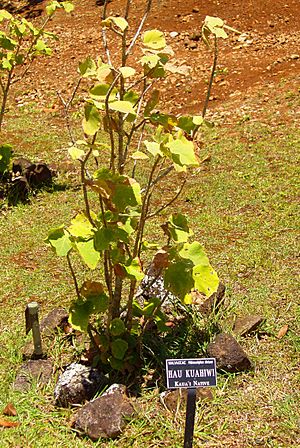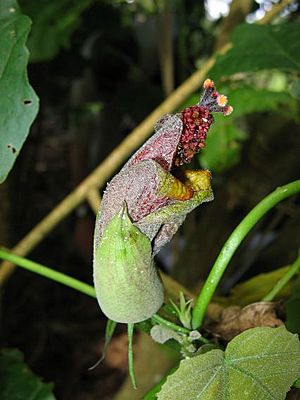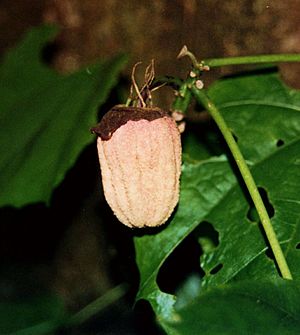Hibiscadelphus facts for kids
Quick facts for kids Hibiscadelphus |
|
|---|---|
 |
|
| Hibiscadelphus distans | |
| Scientific classification |
|
| Kingdom: | Plantae |
| Clade: | Tracheophytes |
| Clade: | Angiosperms |
| Clade: | Eudicots |
| Clade: | Rosids |
| Order: | Malvales |
| Family: | Malvaceae |
| Subfamily: | Malvoideae |
| Tribe: | Hibisceae |
| Genus: | Hibiscadelphus Rock, 1911 |
Hibiscadelphus is a group of flowering plants that are found only in Hawaiʻi. The Native Hawaiians call these plants hau kuahiwi, which means "mountain Hibiscus". The Latin name Hibiscadelphus means "brother of Hibiscus". These plants are special because their flowers do not fully open. Hibiscadelphus belongs to the Malvaceae family, which also includes cotton and okra. Sadly, many species in this small group are now extinct.
About Hibiscadelphus Plants

The Hibiscadelphus plants were first officially described by a botanist named Joseph Rock in 1911. He studied a species called Hibiscadelphus giffardianus.
These plants can be big shrubs or small trees, growing up to 7 meters (about 23 feet) tall. They have leaves that are almost perfectly round. A special feature of Hibiscadelphus flowers is that they never open completely flat like other Hibiscus flowers. Instead, they stay folded in a tube shape. Scientists think this shape helps honeycreeper birds pollinate them. The fruits are rough capsules that hold up to 15 hairy seeds.
When Western botanists first discovered Hibiscadelphus, it was already very rare in Hawaiʻi. This suggests that these plants were becoming uncommon even before Europeans arrived. Four species—H. bombycinus, H. crucibracteatus, H. giffardianus, and H. wilderianus—were only ever found as a single plant in the wild.
Today, four of the known Hibiscadelphus species are extinct. Two species are extinct in the wild, meaning they only exist in gardens or special growing areas. Only one species, H. distans, still has a small, wild population that is in great danger.
One reason for their decline is likely that rats eat their seeds. This problem started long ago when the Polynesian rat arrived with early Hawaiian settlers. Another big reason is the widespread destruction of dry forests, which happened both before and after Europeans came to Hawaiʻi.
Hibiscadelphus Species
Here are some of the known Hibiscadelphus species:
- †Hibiscadelphus bombycinus
* This species is known from only one plant collected before 1868 near Kawaihae, Hawaiʻi. It is now extinct.
- †Hibiscadelphus crucibracteatus
* In 1981, a single tree was found on the island of Lānaʻi. This tree died in 1985. Sadly, efforts to grow new plants from its seeds did not work, and this species is now extinct.
* Fewer than 200 wild plants of this species grow near the Koaiʻe River on Kauaʻi. However, when grown by people, it produces many healthy seeds.
* In 1910, Joseph Rock found a single tree of this species in Kīpuka Puaulu, which is now part of Hawaiʻi Volcanoes National Park. This tree died in 1930, but parts of it were saved and grown. Hundreds of these plants have been planted in the park, but they don't seem to grow naturally from seeds there.
* This species used to grow in the North Kona area. The last wild tree died in 1992. However, it is still grown by people, and some plants have been put back into forest reserves.
* This is a newly described species. About 99 wild plants are known to grow in the Kaua`ula valley in Western Maui.
- †Hibiscadelphus wilderianus
* This species likely became extinct around 1912. It was only known from a single tree found in Auwahi on Maui.
* This species was discovered in 1991 on Kauaʻi. Only four plants were found then; three died by 1998, and the last one was found dead in 2011. Its pollen was not able to create new seeds, and all attempts to grow it failed. However, in 2019, one plant was found on a cliff in Kalalau Valley, and two more were found a month later.
- Hibiscadelphus x puakuahiwi
* This is a hybrid plant, meaning it's a mix of H. giffardianus and H. hualalaiensis. In the 1960s, both parent species were planted on Mauna Loa in Hawaiʻi Volcanoes National Park. They cross-pollinated, and their mixed seeds were accidentally collected and planted. When these hybrid plants were discovered in 1973, many were cut down, but at least one hybrid tree was still alive in 2011.
See also
 In Spanish: Hibiscadelphus para niños
In Spanish: Hibiscadelphus para niños



